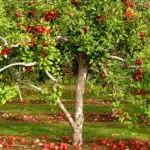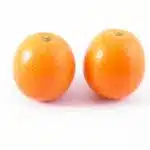The Gravenstein apple tree is a beloved fruit tree commonly grown in gardens and orchards around the world. It is a unique variety of apple tree that produces large, juicy apples with a tart flavor and firm flesh. Its popularity is due to its versatility as it can be used for cooking, baking, making juice, or eaten fresh off the tree. However, like any plant, the Gravenstein apple tree requires proper care and attention to thrive.
Growing and caring for Gravenstein apple trees requires knowledge of their specific needs and preferences. This guide aims to provide helpful information on how to grow healthy trees that produce an abundant harvest of tasty apples. From choosing the right location for planting to pruning techniques and pest control methods, this article covers all aspects of Gravenstein apple tree care. By following these guidelines, gardeners can ensure they are providing optimal conditions for their trees, resulting in a bountiful crop year after year.
Understanding Gravenstein Apple Trees
Gravenstein apple trees, known for their tart and juicy flavor, have a rich history that dates back to the 17th century in Denmark. This variety of apple was named after the Gråsten Palace, where it was first discovered in the late 1600s. From there, it spread throughout Europe and eventually made its way to North America in the early 1800s.
There are several different varieties of Gravenstein apple trees, each with its unique qualities. The most common variety is the Early Gravenstein, which is typically harvested in August and September. Other variations include the Red Gravenstein, which has a more crimson-colored skin than the traditional green-yellow hue, and the Golden Russet Gravenstein, which has a softer texture than other varieties.
When planting a Gravenstein apple tree, it’s essential to choose the right location. These trees require full sun exposure and well-drained soil to thrive. Additionally, they are not tolerant of extreme temperatures or humidity levels. Therefore, it’s crucial to select a location that provides consistent warmth without excessive moisture. By following these guidelines, you can ensure your Gravenstein apple tree will grow healthy and produce bountiful fruit for years to come.
Choosing The Right Location For Planting
Understanding the characteristics of Gravenstein apple trees is important before planting them. These trees are deciduous and grow up to 20 feet tall, with a rounded canopy that spreads up to 25 feet wide. They are also self-sterile, which means they require cross-pollination from another variety of apple tree. Understanding these traits will help in selecting the right location for planting.
Choosing the right location for planting Gravenstein apple trees is crucial to ensure their growth and production. The ideal location should have well-draining soil with a pH level between 6.0 and 7.5, as soil acidity can affect tree growth and fruit quality. Additionally, the location should receive full sunlight exposure for at least six hours daily, as trees require sunlight to produce food through photosynthesis.
Before planting Gravenstein apple trees, prepare the soil by removing any weeds or grass within a radius of at least three feet from where the tree will be planted. Work compost into the topsoil to improve soil structure and nutrient content. Fertilization should be done during the early spring before new growth appears using a balanced fertilizer with equal amounts of nitrogen, phosphorus, and potassium. Proper soil preparation and fertilization will provide a healthy foundation for Gravenstein apple trees to thrive in their chosen location.
Transitioning to the subsequent section on ‘soil preparation and fertilization,’ it’s important to understand how these steps can directly impact the growth and production of Gravenstein apple trees.
Soil Preparation And Fertilization
Like any other plant, the gravenstein apple tree requires proper soil preparation and fertilization to ensure its growth and fruit production. Soil is the foundation of any plant’s growth and development, and it is vital that it is well-prepared to meet the needs of the gravenstein apple tree.
One way to prepare the soil for planting a gravenstein apple tree is through composting. Composting benefits the soil by increasing its organic matter content and improving its structure, water-holding capacity, and nutrient availability. This process also helps in reducing waste, especially kitchen scraps and yard trimmings, while providing a natural source of fertilizer for your apple trees.
Nutrient deficiency is another factor that can affect the growth of your gravenstein apple trees. To prevent this from happening, you need to fertilize your soil appropriately. A soil test will help determine if there are any nutrient deficiencies present in your soil. Based on these results, you can select the appropriate fertilizer that will provide your trees with the necessary nutrients they require for their optimal growth.
To ensure healthy and fruitful gravenstein apple trees, proper soil preparation and fertilization are crucial steps that must not be overlooked. By composting your soil and providing it with adequate nutrients, you can create an environment where your trees can thrive. The next step is planting techniques for gravenstein apple trees which we will discuss in detail in the subsequent section.
Planting Techniques For Gravenstein Apple Trees
When planting Gravenstein apple trees, it is important to consider the spacing requirements to ensure optimal growth and fruit production. These trees require ample space between each other and other plants for proper sunlight exposure and air circulation. The recommended spacing for Gravenstein apple trees is around 20-25 feet apart from each other, with enough room for the roots to spread out as well.
Companion planting can also be a useful technique when planting Gravenstein apple trees. Certain plants can help repel pests or attract beneficial insects that can aid in pollination. For example, marigolds are known to deter pests like aphids and whiteflies, while clover can help fix nitrogen in the soil and improve overall soil health. It is important to research companion plants that are compatible with Gravenstein apple trees before planting.
Proper spacing and companion planting techniques are essential for ensuring healthy growth of Gravenstein apple trees. By providing adequate space for sunlight exposure and air circulation, as well as incorporating compatible companion plants, these trees have a better chance of thriving and producing abundant fruit yields in the future. In the next section, we will discuss watering and irrigation techniques that are crucial for maintaining these young trees’ health.
Watering And Irrigation
Proper watering and irrigation are crucial for the health and growth of gravenstein apple trees. These trees require regular watering, especially during their active growing season. One effective method of providing water to your gravenstein apple tree is by using drip irrigation. This system delivers water directly to the tree’s root zone, reducing water waste and minimizing weed growth.
When implementing a drip irrigation system for your gravenstein apple tree, it’s important to establish a consistent watering schedule. The frequency of watering will depend on various factors such as soil type, weather conditions, and stage of growth. As a general rule, young trees require more frequent watering than mature ones. To avoid over-watering or under-watering your tree, consider installing a soil moisture sensor that can help you determine when to water.
Properly irrigating your gravenstein apple tree is essential for its overall health and productivity. By using drip irrigation and establishing a regular watering schedule, you’ll be able to ensure that your tree receives the appropriate amount of water. In the next section, we’ll discuss pruning and training methods that can help promote healthy growth and fruit production in your gravenstein apple tree.
Pruning And Training Methods
As the Gravenstein apple tree matures, it is essential to prune and train it properly. Pruning not only controls the size and shape of the tree but also promotes healthy growth and increases fruit production. Winter pruning is recommended for this variety as it allows for better visibility of the tree’s structure and helps avoid any damage during the growing season.
Espalier techniques are an effective way to train your Gravenstein apple tree, particularly if you have limited space. This technique involves training the tree along a flat surface such as a wall or fence in a specific pattern. Espalier trees take up less space and receive more sunlight, leading to higher fruit production. However, they require regular pruning to maintain their shape.
Winter pruning should be done annually to remove dead or diseased wood, crossing branches, or any growth that impairs airflow within the tree canopy. It is crucial to make clean cuts at a 45-degree angle just above the bud so that new growth can emerge correctly. Proper pruning ensures that your Gravenstein apple tree remains healthy and productive for years to come.
Moving forward with pest and disease control, it’s essential to keep in mind that prevention is always better than cure. By implementing proper pruning techniques like espalier training and winter pruning, you can reduce pests’ entry points while improving air circulation throughout your tree’s canopy. In addition, regularly inspecting your trees for symptoms of pests or diseases can help you identify potential problems early on before they spread uncontrollably.
Pest And Disease Control
Gravenstein apple trees are susceptible to pests and diseases, which can hinder their growth and yield. However, it is possible to control these threats by adopting integrated pest management (IPM) practices. The IPM approach involves using a combination of methods to prevent or manage pests and diseases rather than relying solely on chemical pesticides.
One of the most effective organic control methods for pests is using natural predators such as ladybugs or lacewings to eat aphids or other insects that damage the tree. You can also use sticky traps or pheromone traps to capture pests like apple maggots before they hatch. Additionally, you can create physical barriers such as netting or fencing to keep larger pests like deer away from the trees.
For disease control, it’s important to maintain good hygiene around the tree by removing any fallen leaves, fruits, or debris that may harbor pathogens. You can also apply organic fungicides made from ingredients like copper sulfate or neem oil to prevent fungal infections. Pruning your tree regularly will also help promote air circulation and reduce humidity levels around the branches, which are ideal conditions for fungal growth.
By adopting these organic pest and disease control methods, you can protect your Gravenstein apple tree without harming beneficial insects or damaging the environment. In the next section, we’ll discuss some tips on harvesting and storing your apples so that you can enjoy them all year round.
Harvesting And Storage Tips
After all the effort put into caring for your gravenstein apple tree, it would be a shame if pests and diseases managed to get in the way of a successful harvest. Fortunately, with proper prevention measures and timely action, most issues can be avoided or resolved. However, some of these problems can be quite vexing.
One example is the codling moth, which lays its eggs in fruit buds and causes wormholes in the apples. To prevent this problem, use pheromone traps to capture male moths and avoid planting trees close together as this encourages infestations. Another issue is powdery mildew, which appears as white spots on leaves and causes them to drop prematurely. To avoid this problem, water your tree regularly and prune any infected branches.
Once you’ve successfully harvested your gravenstein apples, it’s time to enjoy them in various ways. You can make cider by crushing the apples and fermenting the juice with yeast. Alternatively, you can try out some of the best recipes that feature gravenstein apples as a key ingredient such as pies, sauces or jams. Whether you’re looking to impress guests with your culinary skills or simply want to indulge yourself in some delicious treats, these options are sure to satisfy your taste buds.
Now that we’ve covered pest control and harvesting tips for gravenstein apple trees let’s move on to common issues and troubleshooting techniques that may arise when growing these trees. While they are relatively easy to grow compared to other types of fruit trees, there may still be challenges along the way. Let’s explore some solutions together so that you can continue enjoying your delicious harvest year after year!
Common Issues And Troubleshooting
- The Gravenstein apple tree is susceptible to common pests and diseases including aphids, powdery mildew and apple scab.
- Pruning should be done when the tree is dormant to ensure the tree is healthy and has proper airflow.
- Soil quality for the Gravenstein apple tree should be slightly acidic with a pH of 6.0-7.0 and well-draining.
- To prevent pests and diseases, the Gravenstein apple tree should be kept free of dead leaves and debris, and watered deeply and regularly.
- To ensure the tree is growing properly, pruning should be done each year to shape the tree and encourage fruit production.
- To ensure the best soil quality for the Gravenstein apple tree, the soil should be amended with compost or other organic material each year.
Pests And Diseases
As a gardener or farmer, it can be frustrating to see pests and diseases invade your gravenstein apple tree. These issues can destroy the fruit, leaves, and even the entire tree if left untreated. However, with proper prevention methods and organic solutions, you can keep your gravenstein apple tree healthy and thriving.
One of the best prevention methods for pests and diseases is maintaining good hygiene in your orchard. This includes removing any fallen leaves or fruit from the ground and pruning any dead branches. Additionally, planting companion plants such as marigolds or garlic around your gravenstein apple tree can help repel insects. If you do notice an infestation, try using organic solutions such as neem oil or insecticidal soap to control the problem.
When it comes to disease prevention, regular monitoring and early detection are essential. Keep an eye out for signs of common diseases such as powdery mildew or apple scab on the leaves and fruit of your gravenstein apple tree. Proper watering practices that minimize leaf wetness can also help prevent fungal infections. If a disease does take hold of your tree, consider using organic solutions such as copper fungicides or compost tea to combat the issue. With consistent care and attention to managing pests and diseases, you can ensure that your gravenstein apple tree remains healthy and productive for years to come.
Pruning
Effective management of gravenstein apple trees requires a comprehensive approach that involves preventing and addressing common issues such as pests, diseases, and poor growth. One of the most important practices in maintaining healthy gravenstein apple trees is pruning. Pruning promotes tree health, enhances fruit production, and helps to reduce the incidence of pest and disease infections. This article will discuss the tools needed for pruning, the timing of pruning, and some tips for successful pruning.
The right tools are essential when it comes to pruning your gravenstein apple tree. You will need a pair of sharp bypass pruners or loppers for removing small branches and twigs up to 1 inch in diameter. For larger branches or limbs, you will need a pruning saw or chainsaw. Before using any tool, ensure that they are clean and sharp to prevent damaging the tree’s bark. Additionally, disinfect your tools between each cut with rubbing alcohol or bleach solution to avoid spreading diseases.
Timing is crucial when it comes to pruning your gravenstein apple tree effectively. The best time to prune depends on your specific goals for the tree; however, it is generally recommended to prune during the dormant season (late winter/early spring) before new growth begins. During this period, you can easily see the tree’s structure without leaves obstructing its view. It is also important to avoid pruning during flowering since this can reduce fruit production.
To successfully prune your gravenstein apple tree, focus on removing dead or diseased wood first before moving onto thinning out excess growth or shaping specific branches. Thinning involves removing entire branches that are crossing or growing inward towards other branches while shaping entails shortening lateral shoots from main scaffolding branches by about one-third their length. Remember not to remove more than 20% of a mature tree’s canopy at once since doing so can stress the plant too much and result in stunted growth or death.
In conclusion, pruning is a vital practice in maintaining healthy gravenstein apple trees. Ensure that you have the right tools, prune during the dormant season, and focus on removing dead or diseased wood first before thinning or shaping. With proper pruning techniques, your gravenstein apple tree will produce high-quality fruit for years to come.
Soil Quality
As a horticulturalist, one of the most common issues that I encounter when it comes to gravenstein apple trees is poor soil quality. Soil pH and nutrient deficiencies can significantly affect the tree’s growth and fruit production. Therefore, understanding how to maintain healthy soil is vital in troubleshooting any issues related to gravenstein apple tree care.
Maintaining an optimal soil pH is crucial for healthy gravenstein apple trees. These plants prefer a slightly acidic soil with a pH range of 6.0-7.0. If the pH is too high or too low, the tree may experience stunted growth, yellowing leaves, and reduced fruit quality. To maintain optimal soil pH, regular testing should be carried out to determine if any adjustments are necessary.
In addition to maintaining proper soil pH levels, ensuring that the tree has access to essential nutrients is equally important. Nutrient deficiencies can lead to poor growth and weak fruit production in gravenstein apple trees. Therefore, it is essential to fertilize regularly using appropriate fertilizers and methods while also taking note not to overfertilize as this could lead to nutrient toxicity or salt accumulation in the soil. By maintaining optimal soil quality by considering factors such as pH levels and nutrient deficiencies, you can troubleshoot common issues experienced when caring for your gravenstein apple trees effectively.
Frequently Asked Questions About Gravenstein Apple Trees
Gravenstein apple trees are a popular choice among homeowners and orchardists alike due to their unique flavor profile and versatility in the kitchen. However, these trees require proper care and attention to thrive. In this section, we will answer some commonly asked questions regarding the care and growing of Gravenstein apple trees.
What are the best pollinators for Gravenstein apple trees? Gravenstein apple trees are self-sterile, which means they require cross-pollination from another tree to produce fruit. The best pollinators for Gravenstein apple trees include other early-season varieties such as Yellow Transparent or Red Astrachan.
What is the ideal climate for growing Gravenstein apple trees? Gravenstein apples originated in Denmark, where the climate is cool and moist. As such, these trees prefer cooler temperatures and higher humidity levels than other apple varieties. They also require well-draining soil and ample sunlight to thrive.
How often should I water my Gravenstein apple tree? Gravenstein apple trees have moderate water needs and should be watered deeply once or twice per week during periods of dry weather. Avoid overwatering, as this can lead to root rot and other issues.
In summary, if you’re considering growing a Gravenstein apple tree, be sure to choose appropriate pollinators, plant in an ideal climate with well-draining soil and ample sunlight, and provide adequate but not excessive water. With proper care, your tree will reward you with delicious fruit for years to come!
Conclusion
Gravenstein apple trees are a hardy and productive addition to any orchard or garden. Proper care and maintenance will ensure a bountiful harvest of these delicious and versatile fruits. When selecting a location for planting, it is important to consider the tree’s need for full sun exposure and well-draining soil. Adequate irrigation and fertilization will promote healthy growth and fruit production.
Pest and disease control measures should be taken to prevent damage to the tree and its fruit. Harvesting at the right time and storing apples properly will ensure their longevity. With proper care, Gravenstein apple trees can provide years of enjoyment through their beautiful blossoms in the spring, abundant fruit in late summer, and autumn foliage colors. As with any plant, it is important to be aware of common issues that may arise and take measures to address them promptly.
In conclusion, Gravenstein apple trees are an excellent choice for gardeners looking for a reliable fruit source that requires minimal maintenance. By following the guidelines outlined in this guide, you can successfully grow your own Gravenstein apple tree and enjoy its many benefits for years to come. Remember to pay close attention to its needs throughout the growing season, taking steps as needed to promote optimal health and productivity. Happy planting!
Image Credits





























